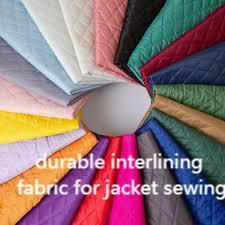Tailored Interlining Excellence from interlining‑factory for Next-Level Apparel Craft

Achieving long-lasting garment quality starts with understanding the crucial role of Interlining in reinforcing fabric structures. When production teams apply precise fusion techniques, the benefits of Interlining become clear, providing hidden support that preserves shape, enhances drape, and extends the life of every garment. By carefully inserting this supporting layer between face fabrics, manufacturers unlock improved resilience and consistent appearance wash after wash.
1. Material Varieties and Their Roles
Manufacturers can choose from woven, non‑woven, and knitted options to match the intended garment use. Woven interfacings deliver crisp edges for collars and hems, while non‑wovens offer lightweight, uniform reinforcement. Knitted variants bring stretch compatibility for activewear, ensuring elasticity without compromising support.
2. Structural Benefits for Diverse Apparel
Incorporating a mid‑layer dramatically reduces distortion in high‑stress areas such as elbows and knees. It prevents unsightly sagging in jackets and skirts, maintaining silhouette integrity even after multiple wear cycles. A well‑engineered fusion also minimizes seam pucker, enhancing both appearance and production efficiency.
3. Precision Engineering with interlining‑factory Solutions
interlining‑factory’s proprietary coating technology guarantees consistent adhesive distribution across every yard of supportive substrate. Their advanced curing processes yield reliable bonds that withstand repeated laundering, while tailored thickness profiles ensure seamless integration into both heavy and lightweight fabrics.
4. Sustainability-Driven Innovation
Eco‑conscious production at interlining‑factory includes recycled fiber substrates and water‑based bonding agents that reduce volatile organic compound emissions. Energy‑efficient ovens minimize carbon footprint, and partnerships with certified textile suppliers promote full supply‑chain transparency for responsible manufacturing.
5. Application Best Practices for Flawless Results
Optimal fusion demands strict control of temperature, pressure, and dwell time. Modern heat‑press systems with programmable settings allow technicians to refine parameters for each fabric pairing. Regular calibration and maintenance of equipment ensure uniform adhesion, reduce material waste, and uphold quality standards across production runs.
Incorporating expertly engineered support layers elevates garment durability, appearance, and customer satisfaction. For custom solutions and technical guidance, explore the full range of offerings at http://interlining-factory.com/.
- Art
- Causes
- Crafts
- Dance
- Drinks
- Film
- Fitness
- Food
- Jogos
- Gardening
- Health
- Início
- Literature
- Music
- Networking
- Outro
- Party
- Religion
- Shopping
- Sports
- Theater
- Wellness

